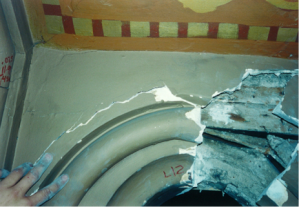Each week we’re bringing you an in-depth look at one of the standard conditions we encounter and document during inspections of buildings and civil structures.
Part 16: Plaster Conditions
Plaster is a finish material used principally for interior walls and ceilings. Ubiquitous in buildings of all types until well into the 20th century, plaster’s low cost and ease of workability made it a natural choice for creating interior finishes ranging from simple to ornate. Historically, flat plaster was applied to walls and ceilings in two or three coats over a wood lath substrate. Decorative moldings, coffered ceilings, and ceiling medallions were either formed on-site or cast in molds. Plaster may have a variety of finish treatments, including surface textures, wallpapers and decorative painting, sometimes in imitation wood or stone.
We document failed coatings; cracks; sound and failed crack and patch repairs; failed lath; replacement repairs; water damage and water staining; and unsecured plaster.
Structural movement and vibrations from vehicle traffic or construction activity can cause plaster to crack, often at the corners of rooms or at the corners of windows and doors. Water staining is usually indicative of roof or plumbing leaks, which can eventually lead to significant deterioration and cracking, separation from the substrate, and failure. Substrate failure may occur due to rusting fasteners or other modes of deterioration. Plaster keys (the plaster that oozes between the lath, forming a mechanical bond) can be damaged or broken by inappropriate treatment – for example, a plaster ceiling in an exposed attic space may be carelessly walked on. Later building modifications, such as retrofitted mechanical systems and interior reconfigurations, often result in substantial damage to plaster walls and ceilings.
Next in this series: Metal Conditions
Click here to see all posts in this series.
Click here for an index of all posts in this series, or download a pdf of the complete series.

